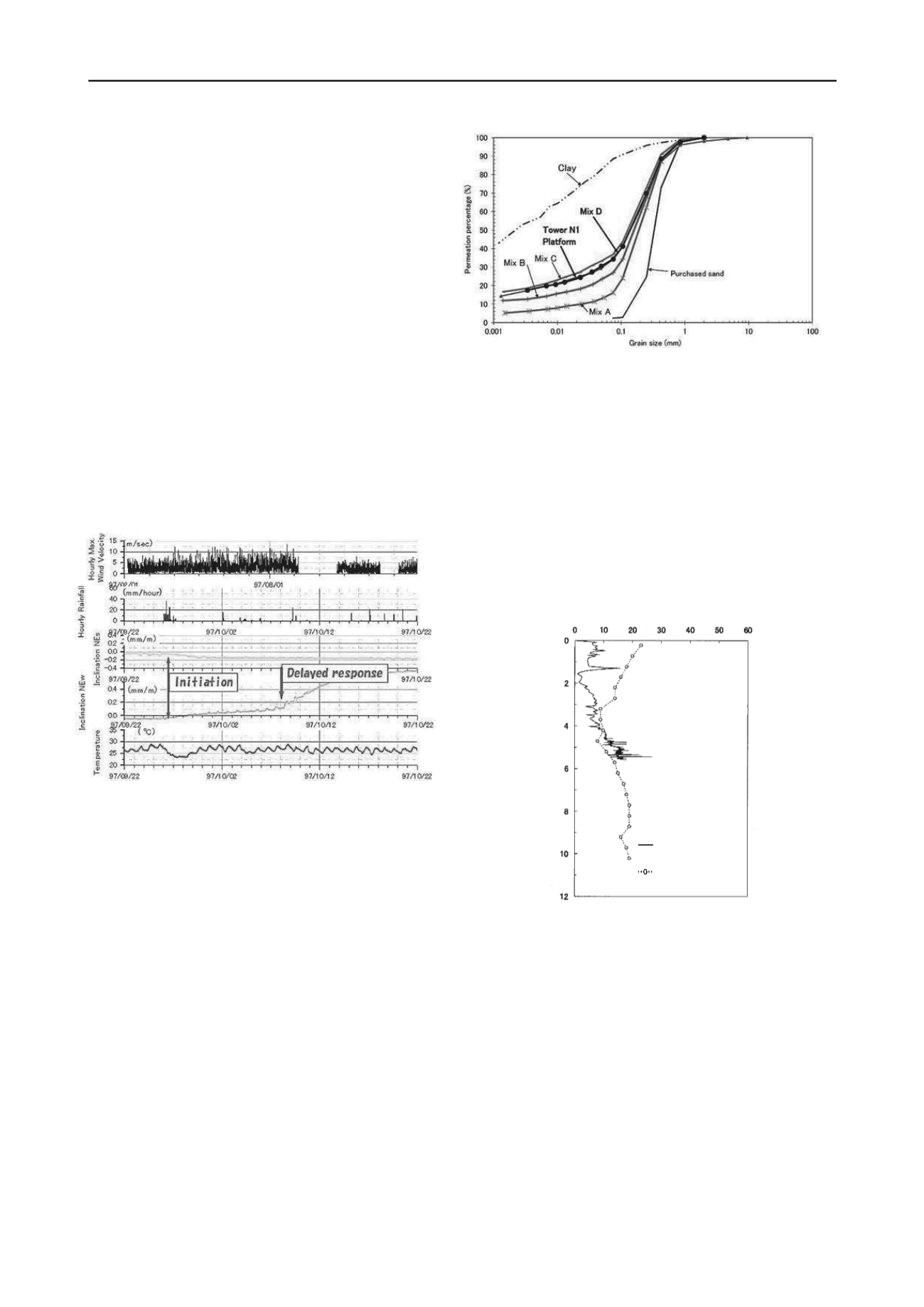
3096
Proceedings of the 18
th
International Conference on Soil Mechanics and Geotechnical Engineering, Paris 2013
Proceedings of the 18
th
International Conference on Soil Mechanics and Geotechnical Engineering, Paris 2013
3.1 Case history
N3 tower (one of Prasat Suor Prat) was restored by École
française d‘Extrême
-Orient in 1950, and its superstructure was
dismantled and rebuilt.
50 years after its restoration, it inclined once again and
structure materials for its openings were broken. It has been
recognized that N3 tower is at risk of collapse. This leaning of
N3 tower is supposed to have occurred during restoration work
or just after it. It was thought to be caused by fact that
superstructure was treated, and its platform and its base ground
were not treated.
3.2 Survey of existing state
The change in N1 tower’s inclination with progressin
g time has
been monitored by plumbing, however there was no significant
change. During the rainy season in October in 1997, when there
was wind velocity of over 10m/s blew for a few days, 0.5mm/m
of the lateral displacement was measured. Figure 1 shows this
monitoring data with inclinations, wind velocity, rainfall and
temperature for N1 tower. This fact shows that the tower’s
displacement was increased by the external force acting against
the tower (in this case, gust wind during rainy season), and this
displacements will be accumulated.
Figure 1. The measuring results of the amount of inclinations, the wind
velocity, precipitation, and temperature of N1 tower.
Based on these facts, it is recognized that the foundation
platform and the ground under it should be investigated in
detail. First, a soil survey by hand auger was carried out, but
results of it were insufficient to clarify the soil strata under the
platform. It was concluded that the investigation of the tower
state should be done by dismantling them, including excavating
the base ground. Moreover, it is decided that these results will
be used for designing of other ruins’ restoration projects in
future.
Photo. 2 and Figure 2 show soil strata under the platform of
N1 tower. The compacted sandy formation was found from -
1.5m from the original ground surface and to +3.5m above the
ground, which the average thickness of one stratum was
measured about 20cm. Figure 3 shows the grain size
distribution curve of them. Figure 4 shows N-value distribution
(by using standard penetration test) with depth. In figure white
dots show the values in the dry season and the polygonal line
shows them in the rainy season.
Photo. 2. Soil strata under the platform of N1 tower
Figure 2. North-South Section of N1 tower (Before restoration)
Figure 3. Grain size distribution curve of each soil
The average in-situ dry density of the compacted strata was
measured at 1.69g/cm
3
at center of it and 1.73g/cm
3
directly
under laterite blocks. Because the maximum dry density by
Proctor’s compaction test was measured at 1.88g/cm
3
, these
compacting layers were assumed to have been tamped with
about 90% on degree of compaction.
Plate bearing in-situ test of plate loading on original
compacted sandy ground showed the yield load of 290 - 340
kN/m
2
under wet condition. Since the contact pressure in the
ground beneath the foundation of the tower was estimated at
270kN/m
2
, the safety factor against the ground bearing capacity
in rainy season was calculated at SF=1.1, which was considered
as small and not safe. When the external force acts on the tower
in the rainy season, the inclination, the subsidence and the
differential settlement of them will increase.
Figure 4. N-value distribution
4CONSTRUCTION METHOD
The principle for this reconstitution is to adopt the original
tamping method for excavated original soils. However, if the
bearing layers are reconstituted by the original tamping method
with original soils, their bearing capacities will be same as
original states and capacity reduction in rainy season will not be
avoided. When constructed with the original excavated soil, it is
concluded that it should be improved with some stabilizing
materials for soils.
In the case of surface soil stabilization in place, Portland
cement or hydrated lime is used as a hardening agent. Hydrated
lime should be accepted for this case, because it is easy to buy it
near the jobsite and to handle it for working. Moreover it is used
for long time.
N value and Presumed N value
B-No.5
(94 rainy season)
BY1A
(95 dry season)
Depth (GL-m)


